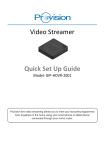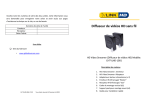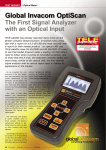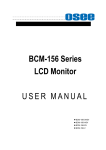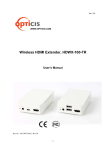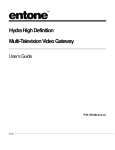Download TVLink HD Coax User Manual V1_0a
Transcript
Coaxial HD Video Streamer HD Video Streamer Model: Mode GI-TVLHD-1002 Package Contents 1. 2. 3. 4. 5. 6. 7. 8. HD Video Streamer :Transmitter Unit HD Video Streamer: Receiver Unit Wall Plug Mains Power Adaptors (x2) IR Transmitter (Blaster) IR Receiver (Eye) Vertical Mount Stands(x2) Wall Mount Brackets (x2) Quick Set Up Guide. DC input: Only connect the supplied wall mount power supplies. Connection of wrong supplies may cause permanent damage to the unit or prevent it working correctly IR input: Connect IR Blaster and position in view of the source IR sensor IR input: input Connect IR Eye and position in view of the remote control. RF Coaxial Input: Input Connect to TV RF link: Connect to Home Coaxial Network HDMI Output: Connect to main TV HDMI Output : Connect to remote TV HDMI input: Connect to STB HDMI output Transmitter Power Indicator LED Green: Normal Amber: Flashing IR activity Steady: USB upgrade Wireless Indicator LED Blue: Flashing: trying to connect /waiting for source Steady: Connected Steady : USB upgrade Receiver Accessories Wall Plug Power Supplies Two 5.5V 2.0 A wall plug power supplies are supplied for the transmitter and Receiver units. They are identical and can be interchanged. Only use the power supplies provided. Use of other power supplies may result in incorrect operation or permanent unit damage and will invalidate any warranty. IR Control Using the IR accessories supplied you can control your HD source from the remote TV. Connect the IR Eye to the receiver unit and the IR Blaster to the Transmitter unit. Use the HD source handset to control your content as if you were at the main TV. IR Eye: Connect to Receiver Unit and position the Eye to be visible by the remote control handset IR Blaster: Connect to the Transmitter unit and position in front of HD source IR Sensor Base Stand The Aluminium Stands provided orientate the units. Page 2 Installation and Connection Diagram Page 3 1. Remove all parts from packaging and identify each part: 2. On the Transmitter Unit: Connect a good quality HDMI cable from source HDMI output to the transmitter HDMI (input) connector. If you are going to view the content on a main TV connect another good quality HDMI cable between the transmitter HDMI output (TV) connector and the TV HDMI input. Connect the IR Blaster into the IR socket and position the blaster in front of the IR sensor on the set-top box, (refer to its handbook for position of sensor). A set-top box source will have an RF output (RF2) which should be connected to the coaxial RF input of the HDMI transmitter. The home network coaxial cable should be connected to the LINK output of the Transmitter unit. Switch on the power to the main TV and turn on the set-top box. Connect the power adaptor jack plug into the DC input of the HDMI transmitter unit and mains plug in to the wall socket. Switch the mains power on and the unit will begin its installation. 3. On the Receiver Unit connect the HDMI output to the remote TV HDMI input using a good quality HDMI cable. Connect the IR eye to the IR socket and position the IR eye such that it can be seen by the remote control handset. Connect the RF output of the HDMI transmitter to the RF (aerial) input of the TV. Switch on the power to the TV. Connect the power adaptor jack plug into the DC input of the receiver unit and the mains plug in to the wall socket. Switch the power on and the unit will begin its installation. 4. The units will automatically configure and connect. During installation the TV will display a start-up screen and the Blue LED will flash indicating the wireless is connecting. Once connected the Blue LED will stop flashing and the units will be able to stream video when sent from the HD source. Page 4 Technical Specification Dimensions mm (inches) Supported HD Resolutions Supported Audio Formats Compression : Video : Audio Content Security HDMI Connectors :Transmitter : Receiver Range IR Control Power Adaptor Operating Temperature Range 136mm x 145mm x 34mm (5.3”x 5.7” x 1.3”) 1080p60/50/24, 1080i60/50, 720p60/50, 576p50, 480p60, 480i60. Stereo PCM H.264/MPEG4-AVC High profile MPEG2 Paired receivers with WPA2 AES HDCP Single input, single output (loop through) Single output >150 Meters depending on Coaxial cable loss IR Eye on Receiver: IR Blaster on Transmitter AC Input: 90V -264V 50/60 Hz DC Output 5.5V 2A. +5°C - +40°C, indoor use only Both the transmitter and receiver units come pre-loaded with all operational software required; the user simply connects the units and powers the units using the supplied wall plug adaptors. The transmitter and receiver then automatically go through a configuration routine. When completed the units are ready to stream HD video. Software updates and functional upgrades will be made available in the future to enhance the performance of the units. These software upgrades will be available to download from the company website and should be stored onto a USB stick. Software upgrades are performed by connecting the USB stick in turn to both transmitter and receiver units. With the USB stick connected to the USB port the power is cycled and the upgrade is automatically loaded. If required units can be returned to the factory default settings by holding down the reset switch and power cycling the unit. This will return the unit to the original software version as supplied from the factory at manufacture and should not be done unless instructed by the product support team. Page 5 Troubleshooting guide General note: Check all connections between transmitter and receiver units with the source and TV are correct and not damaged. Please refer to the set up configuration instructions if unsure. I do not see a picture on the remote TV • • • • • • Check that the TV is switched on Check the TV is set to display from the HDMI port. Check that the Receiver Green and Blue LED are on (not flashing). No LED: check the power supply is connected and switched on at the wall plug. Blue LED is flashing fast: Receiver is not connected. • Check Transmitter • Check the coax connection from transmitter to receiver. Blue LED is flashing slowly: Connected but waiting for Source input • Check Source is switched on • Check HDMI cable between Source and TX input connector. Restart the Receiver (power cycle) Check the HDMI cable between the Receiver unit and TV is connected and not damaged. Replace HDMI cable Check the picture quality through the coaxial RF output port directly to the TV RF input The picture quality on the remote TV is poor • • • Check the coax connection from transmitter to receiver. Reposition the Receiver unit: Signal strength maybe too low or on the edge of range. Check the picture quality on the main TV (Transmitter Loop through). If this is poor then the quality of the input signal is inadequate. Page 6 I get an HDCP warning on the HDTV but no video • No sound on the remote TV • • • • Some sources have Content Protection & Authentication issues; please check with the manufacturers for software upgrades. Disconnecting then reconnecting the HDMI connectors can sometimes solve the problem. Check the volume setting on the TV. Check the volume setting on the source. Check the HDMI cable is not damaged, unplug and inspect, reconnect. Restart the Receiver (power cycle). I cannot control my source device from the remote location • • • Check the IR Eye is not damaged and is connected correctly to Receiver unit Ensure the IR Eye is positioned correctly to be seen by remote control Check the condition of the batteries in the remote control Check the IR blaster is not damaged and connected correctly to Transmitter unit. Ensure the IR Blaster is positioned correctly to be seen by source IR sensor. the the the the Ensure any inline amplifiers have a HDMI bypass kit fitted to allow correct control of the IR sensor. Page 7 Frequently Asked Questions • Are all makes of HDTV supported? The HDMI standards imply that complete interoperability should be possible but some products may implement these rules slightly differently to others leading to complications with some combinations. See the specification page for the list of resolutions and frame rates supported. Some monitors may have a HDMI connector but not support HDCP and will lead to authentication errors. • Are all source devices supported? In general most HDMI sources should be supported. • Are all IR remote controls supported? The unit operates an IR pass through and requires no advance knowledge of the codes used and hence supports all 34-38 kHz remote controls. • How do I set up the units? The setup of the units is a simple procedure described in the set up guide. • What is the range of the units? The range of the units in low loss cable is over 150 meters. In a building the exact range will depend upon the quality of the coaxial cable used the number of interconnects and splitting sections, the higher the cable loss, the shorter the range. Under high loss conditions the signal strength will be seen to be low at start up and the units may need repositioning to increase the received signal strength. • Is it possible to upgrade the units? Upgrades and additional features are planned for the future and will be made available on the website for downloading. The upgrade software is saved to a USB stick and is automatically loaded when connected to the USB port of the units and the units are power cycled. • Can multiple receivers be connected to the transmitter? This feature is under development future software upgrades should provide this capability. Page 8 • Will the units allow gaming? The HD Video Streamer is not optimised for fast moving gaming applications. The encoding and compression techniques used are targeted at efficient and stable video transmission which introduces a small latency (delay) between the source and the remote location. • How long do the units take to configure? A unit will typically take 1 minute to self-configure and connect. • Can I use the streamer for standard definition video? Yes the Video Streamer will transmit both HD and SD video. • Can I transmit to mobile devices? This feature is under development future software upgrades should provide this capability • Can I show different channels on the loop through and the remote TV? The Video Streamer operates as a HDMI extender (repeater), the transmitter unit has a single HDMI input hence the units will always display the same content on the loop through port and the remote location. The loop through TV can still display from a different input (HDMI 2, SCART or other RF) if required. • How important is the quality of the HDMI cable connecting the units to the Source or HDTV? There is a large selection of HDMI cables on the market. It is a question for debate whether the most expensive cables offer significant improvement over lower priced cables in a domestic environment. What can be said is that maintaining a good ground throughout the system is critical and that the inexpensive cables often have a less effective ground connection which will impact the performance in some configurations and in some extreme cases will prevent the system working correctly. • How do I measure the signal strength between the units? Power cycle the receiver: The received signal strength is displayed on the remote HDTV when the unit reconnects after a power cycle. The colour coded indicator bar will help provide an indication of signal strength. • What is HDCP? High-bandwidth Digital Content Protection: Intel Corporation developed copy protection; Implemented through a combination of authentication and encryption to prevent eavesdropping and illegal reproduction. Page 9 Safety Points Please read these instructions fully. Do not operate near water or where there is a risk of spilling any liquids into the units. Remove the units from the power supply or wall plug before cleaning. Clean with a dry cloth. Do not place near any heat source. (e.g. Radiators, Stoves or any other equipment producing heat) Do not block ventilation holes and operate in the recommended orientation. Do not insert any objects into ventilation holes that might touch circuit voltage points or areas that might cause electrical shock. Only use the AC power adaptors supplied. Use of other power supplies may cause malfunction or permanent damage. Do not use an AC power supply if there are any signs of damage to case or wiring. Do not handle the units or power adaptors with wet hands. Disconnect the AC power adaptor from the mains when not in use. Mounting Configurations There are three possible mounting configurations for the HD Video Streamer: Vertical Mount using the supplied base stand. This is the recommended orientation for maximum coverage. Horizontal Mount: The unit has rubber feet to protect mounting surface. It is advised that the unit should not be placed on other electrical equipment or performance could be affected. Wall Mount: Using the supplied bracket, the unit can be mounted on a wall or other vertical surface. Slide the unit into the bracket from the side In whatever mounting configuration adopted, care must be taken to ensure the units are placed in a safe and secure position. Do not place the units in any position where the cables and wiring may become entangled or cause a trip hazard Page 10 This equipment incorporates High-Definition Definition Multimedia interface (HDMI™) technology. HDMI, the HDMI logo and High Definition Multimedia Interface are all trademarks or registered trademarks of HDMI licensing, LCC. This is a class B product, in a domestic environment; this product may cause radio interference, in which case the user may be required to take adequate measures This symbol indicates that when the end user wishes to discard this product, it must be sent to separate collection facilities for recovery and recycling. By separating this product from other household waste, the volume of waste sent to incinerators and landfill will be reduced and natural resources will be conserved. If uncertain please ease contact your local authority for advice. Packaging materials are principally recyclable and wherever possible should be recycled. Materials such as plastic bags should be kept away from children. P Page 11 Please record the serial numbers of the two units, this information will be required to register the purchase and gain access to the support pages of the website if required. Unit Serial Numbers Transmitter Unit Receiver Unit Date of Purchase Useful Links Company Websites • www.globalinvacom.com GI-TVLHD-1002-QSG V1.00 Copyright GI Provision Ltd 2012












